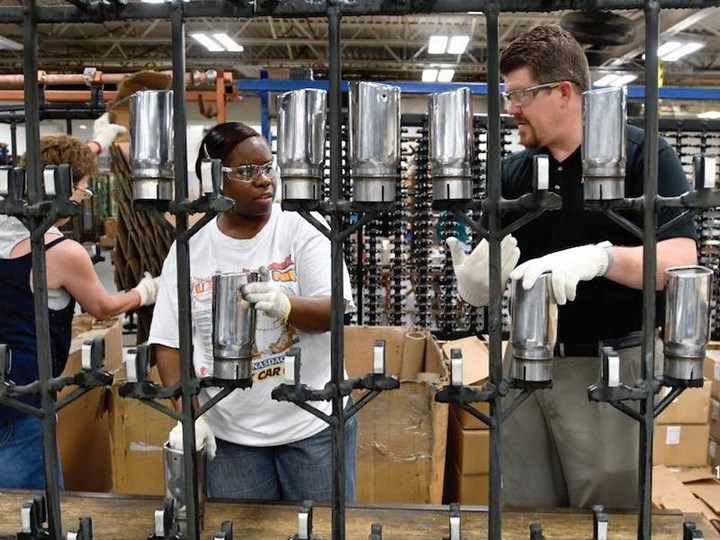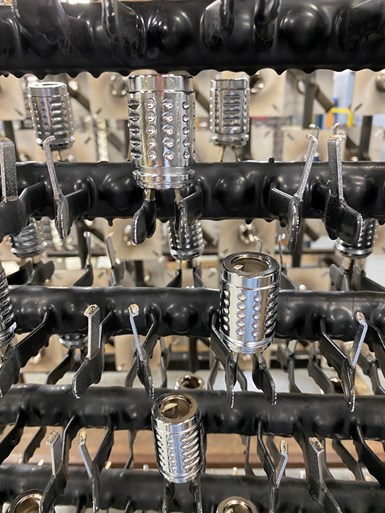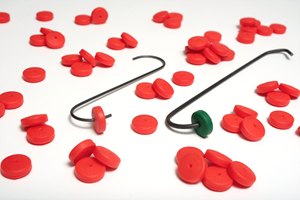
While automating the movement of material on a mechanical finishing line can be highly effective, automatically loading and unloading individual parts onto racks often requires numerous steps and a level of accuracy that is difficult to automate, particularly when handling parts of various shapes and sizes.
Photo Credit: All photos courtesy of Master Finish Company; MasterFinishCo.com
The disruptions to our global manufacturing base, particularly over the last couple of years, have resulted in a struggle to maintain production levels while learning to work with limited access to materials and labor. Therefore, many businesses have started looking at automating their processes sooner rather than later.
In light of competition, the rising costs of doing business, and the desire to provide better and faster service to their customers, every manufacturing company is looking to improve their operations with some type of automation. Fortunately, across the manufacturing landscape, you can find countless numbers of software applications, machines, and robotics, which are being developed to address nearly every application imaginable.
Some automated conveyor systems now offer the ability for each carrier of different parts to be routed for different colors and different cure times on the same system. Variable speed motors and variable frequency drives automate conveyor carriers accommodating greater line density. Multiple lines with smaller footprints and the ability to move individual product carriers forward and backward provide finishers more flexibility and options. ID tags and tracing capabilities allow real-time monitoring of every product at every stage in the finishing process.
When it comes to automating various operations within a finishing system, there are a number of companies with automation experience. Whether stationary, semi-automatic, or robotic, automation can be controlled with precision, reducing paint and material usage. Automated lift assist equipment is useful for handling material safely and with large payloads reducing or eliminating repetitive motion injuries. Automated carousels or rotisseries handle multiple parts at one time, presenting materials for operations to be performed in a timely and consistent manner. Robot painters relieve manual fatigue, saving time from switching operators and ensuring a full day’s work every day. Down-time for breaks and line gaps are eliminated. Robot painters can free up manual painters allowing that person to move to areas designated for inspection, loading and unloading of parts to and from parts finishing racks. Quality and consistency are dramatically improved by the automation in these areas and more.
While the demand for automating finishing lines is greater than ever before, Cliff Semmler with Air Power Inc. (High Point, N.C.), an integrated systems and automation company, has found that the majority of their customers are still manually loading and unloading individual parts on and off of their finishing racks. Kevin Averette of Air Power has also found in his experience that automation often removes bottlenecks in the paint systems with robots improving all the processes except the loading and unloading of individual parts onto racks, resulting in the demand for increased numbers of people in the loading and unloading areas.
Air Power has found that often after they have added a robot to perform the painting operation, the person doing the manual painting before, moved to loading, unloading, and inspection of parts. Moreover, a project where a manual painter was completely overwhelmed trying to keep up, after a new robot painter was installed, the person was not only relieved of the stress, but also moved to loading, unloading, and inspection where their skills were needed.
It’s important to note at this point, a consistent theme that I’ve heard repeatedly, “…automation does not usually increase line speed, but rather increases line density.” This explains why after automating some portion of the finishing line, more people are often needed in the parts racking area. There are more parts being finished than before automation was introduced. Therefore, since we know that by adding automation to the finishing system, a new bottleneck is created in the loading and unloading of individual parts, the obvious question is why not automate these operations as well?
When automating any operation, one of the key questions that must be answered is how many identical operations (not just similar or run in a different sequence) will be performed on a constant basis? If the number of identical operations is high, it’s likely that automating it can be done and probably will be cost-effective at some point.
On the other hand, if there are similar (not identical) operations that are repeated often day after day, but due to minor irregularities even the slightest amount of human intervention is required, automation, although possible, may not always be faster or cost-justified.
John Mulder, President of Master Finish Company (Grand Rapids, Mich.), has experience with implementing automation into his company and he accomplished three main objectives. First, to make their plating services more cost-effective for their customers. Second, to better circumvent the COVID-19 labor shortages, and third, to limit mundane types of work for his employees. However, on his journey to automation, he found that some operations merit the investment immediately and some did not.
Automation is very effective in moving parts on all three of their plating lines from the dock, through plating, and on to inspection, requiring far less staff. The mechanical operation of moving racks of parts — up, over, down, repeat — through a series of plating tanks is an identical process, although performed in different sequences, the same mechanical operation is repeated hundreds of times a day. The high-volume repeatability of this operation lends itself perfectly to an automated process that not only used to be manually controlled and is now computer-controlled, but new, cleaner electric motors now provide better quality plating baths. Software is used to schedule and trace material on parts racks with ID tags as it moves, also giving clients real-time updates on where their parts are in the plating process.
But while conveying high volumes of material on identical flight bars and barrels via computer control through various tanks can be highly effective when automating the movement of material on a mechanical line, automatically loading and unloading individual parts onto racks — another continuously repeated task for the line — is something altogether different. A robot would be required to pick up a part, orient it into a specific position, and place it securely on a spring tension clip on the rack specifically designed for that unique part. This prompts several questions. How many robotic hands are required to handle those tasks? How can the robot touch the part without damaging the surface finish? How do you deal with a robot that drops a part? And what about other similar parts that require similar racking but with ever so slight differences? Since robots utilize precision movement, robotic vision systems would be required to distinguish every part from another and every rack clip design from another. Adding to this complexity, rack manufacturers as a whole do not typically build racks with the precision needed to accommodate robotic repeatability. Only a few rack manufacturers use CNC accuracy in their build process.
It’s common that robotic vision systems require 30% to 40% more cycle time than program-driven robots making the final operation no faster than people and, in most cases, slower. When robots require cameras to communicate with PLCs, the task of loading a single part becomes very complex, especially if multiple robotic hands are involved. And, with Master Finish having a low volume, high mix of parts, it makes their parts racking automation with currently a 10 to 15 year ROI, more difficult to justify. One of the options they are looking at is possibly using robots to load and unload individual part rack precision-made splines. The splines could be automatically loaded onto rack frames. The future for parts racking automation is still very promising. The applications are increasing in number and the ROI time is getting shorter. Their company will continue to keep up with the advancements in automation technology for when the time is right.

Proper parts rack design is critical to the efficiency of automation.
Rack design and automation
It’s important to note that whether automation is implemented or not, line density is key to an efficient finishing line, and parts racks are the key to line density. Parts racks must be uniquely designed to hold the maximum number of parts possible in the most efficient manner possible.
Poor part rack design, coupled with poor conveyor utilization and presentation of parts, will result in costly finishing line inefficiencies. It will also decrease throughput, increase defects and lower production yields dramatically. Part grounding and fire safety can also be directly related to poor part rack design.
However, when proper part rack designs are coupled with proper paint robotic programs, line density and parts production are dramatically increased yielding immediate returns on investment (ROI). Parts racking is extremely important to the efficiency of automation allowing robots to increase throughput, quality and yields. When using 3-D vision systems to determine exact part position, properly designed parts racking is acutely important.
High density parts racks and safety
As parts racks are designed for the maximum number of parts, whether the parts are loaded and unloaded automatically or manually, generally the volume of the parts being placed on the racks requires the operation to be stationed away from the finishing line itself (off-line). The more automation required to load and unload the parts, the slower the process, and the greater the need to be stationed off-line. When manually loading and unloading mass numbers of parts, it’s more efficient to design the racks to hold the maximum number of parts possible and move the loading off-line if possible. Even if part-time workers are necessary to load and unload parts racks off-line, it will pay for itself with increased line density and increased parts production.
Good racking has always equated to high density racks, and highly productive finishing line managers refuse to slow the line speed to accommodate the pace of people loading and unloading parts. The best finishing manager I ever met, who ran the fastest and most productive line I’ve ever seen, once said to me, “…parts racking is an absolute given in every job quote — it’s not an option.” Wise finishing managers use good parts racking.
Off-line loading/unloading requires the ability to move pre-loaded parts racks to and from the finishing line using mobile carts and/or automated lift assist equipment. Often the number of parts per rack will exceed a reasonable weight that can be safely moved by a person at a loading and unloading station where the racks must be placed on or taken off of the conveyor. Automation suppliers can provide lift assist equipment used to automate this operation. A reputable automation equipment supplier should carefully study the payload capacity of the robotics, the ergonomics, and safe repetitions within a certain time and in the specific places for safety and often eliminate safety hazards.
In conclusion, adding automation to finishing lines is an ongoing pursuit for many companies. The software applications and equipment are as unique as the customer. Depending on the products being finished, the ROI for automation may be almost immediate, or it may take a while. Not all operations are justifiable or feasible to automate. Although automation may not add to line speed, it will likely add to line density and increase production. Quality and consistency of the finished product will almost always be improved. If automation is not a viable option, racking for greater part density yields increased production, and is definitely the absolute ROI for any finishing line.
About the Author

Dan Davitz
Dan Davitz is an Industrial Finishing Line Consultant with over 30 years’ experience internationally, specializing in rack design.
He is Founder and Independent Consultant at Prism Strategy & Design, LLC. For more information email: Info@PrismStrategyAndDesign.com
Related Content
Film Thickness Control
Have a powder coating job that requires precise film thickness control? Products Finishing columnist Rodger Talbert offers advice controlling the variables that can impact your success.
Read MoreCFS Unveils New Hook Locks Parts Racking Solution
New product from Custom Fabricating & Supplies (CFS) prevents part loss during coating processes.
Read MoreTroubleshooting 5 Common Racking Problems for Platers
Being aware of usual issues that might occur during the plating process will prepare platers by helping them know how to avoid them all together or how to fix them if they happen.
Read MoreFABTECH 2024 Heads to Orlando
CCAI’s FINISHING Pavilion and Conference continues to grow at FABTECH, offering insights and innovations covering all aspects of industrial surface finishing.
Read MoreRead Next
Conveying Long Parts Horizontally
Industrial finishing line consultant Dan Davitz offers advice for designing racking for navigating long parts along a monorail conveyor.
Read MoreImproving Productivity Through Good Racking Design
Industrial finishing line consultant Dan Davitz offers ideas for optimizing and managing your racking procedures to improve productivity.
Read MoreThe Cost of Rehandling Parts
Good racking design can increase production rates and save labor costs.
Read More














.jpg;maxWidth=300;quality=90)







